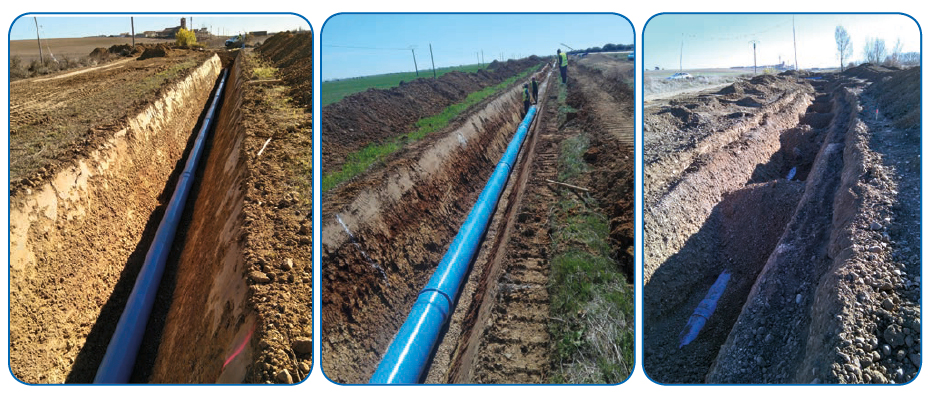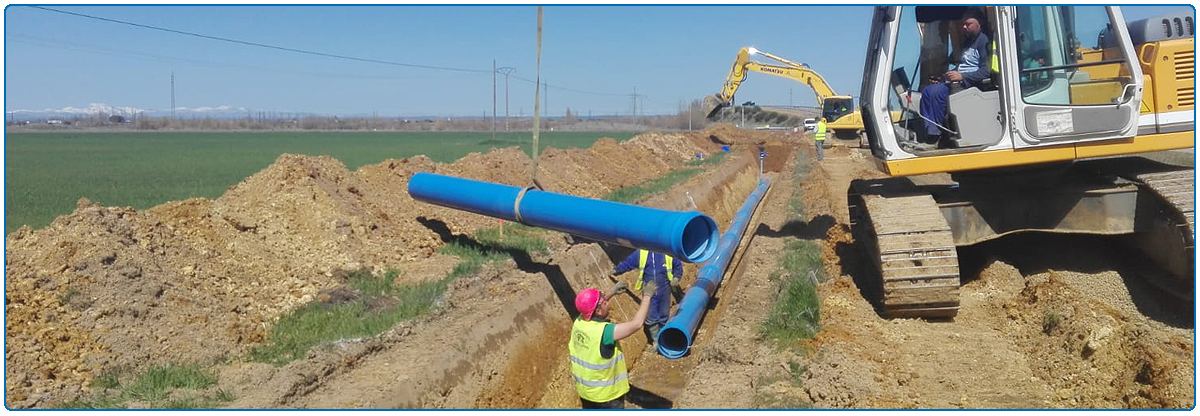
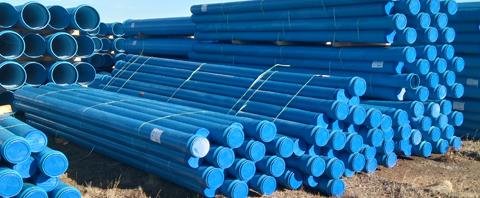
In 1986, the Economic and Social Transformation of the Irrigation Zone of the Riaño Reservoir was declared of National Public Interest. Thus, the necessary infrastructure development was c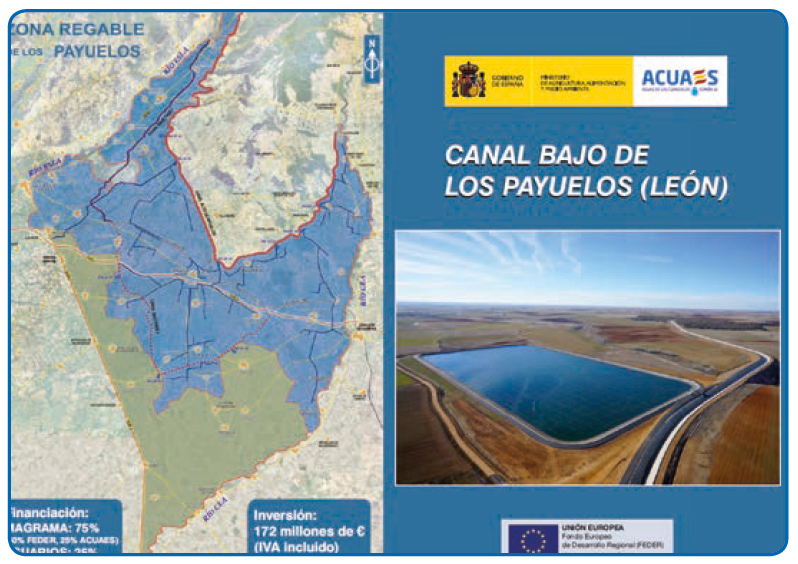 ommissioned for putting in irrigation in several zones in the province of Leon, among which the one in Payuelos stands out.
ommissioned for putting in irrigation in several zones in the province of Leon, among which the one in Payuelos stands out.
The Payuelos sub-zone is a large territory with a total surface area of close to 74,000 ha, of these, a 39,600 ha surface is to be irrigated.
Payuelos’ High and Low Channels were designed to enable the irrigation of this broad area, which after diverting a 24 and 36 m3/s fl ow respectively from the Esla River, the water was transported through a 125 km channel to 9 regulati on reservoirs with a total 1,800,000 m3 capacity, approximately.
The Project for the Payuelos High Channel’s Main Branches, Cea Zone, by Aguas del Duero, included the intake works from the Payuelos High Channel, the irrigation reservoir and the main pipeline network of Sector XXII, which is the distribution network’s starting point from which this project was carried out.
In accordance with the Declarati on of National Public Interest, the area affected by the transformation encompasses a surface area of 74,551 ha in the provinces of León and Valladolid. The municipal boundaries affected by the transformation are:
- León: Bercianos del Real Camino, Calzada del Coto (1,868 ha)*, Castrotierra de Valmadrigal, Cea (17 ha)*, Cistrierna, Cubillas de Rueda, El Burgo Ranero, Gordaliza del Pino, Gradefes, Izagre, Joarilla de las Matas, Mansilla de las Mulas, Sahagún de Campos (752.65 ha)*, Santa Cristina de Valmadrigal, Santa María del Monte de Cea (93.25 ha)*, Santas Martas, Valdepolo, Vallecillo, Valverde-Enrique, Villamartín de Don Sancho, Villamol (339.39 ha)*, Villamoratiel de las Matas, Villasabariego y Villaselán.
- (*)The municipal boundaries aff ected by the transformation in Sector XXII, total irrigable surface 3,070 ha.
- Valladolid: Mayorga, Melgar de Abajo, Melgar de Arriba, Monasterio de Vega y Saelices de Mayorga.
The project’s purpose is the irrigated transformation of the Payuelos sub-zone (Sector XXII) - Cea Area - of the Irrigable Area of Riaño (León, Spain).
A series of actions are considered for the different sectors in which the Payuelos sub-area has been divided, among which is Sector XXII, which includes those described in the current project. This sector has a total area of 6,679 ha, of which 3,070.34 ha are irrigated, belonging to 563 owners and distributed in 712 plots.

The works consisted of execution of the irrigation network, supply and drive piping, the pump station and its electrical installations to transform 3,070 ha.
In the weather conditions prior to the transformation, unirrigated, it was possible to grow cereals (wheat, barley, oats) and grain legumes (peas, beans). Additionally, now with the irrigation, it will yield corn, cryophilic fruit trees, potatoes and beets.
The available resources come from the Riaño reservoir, that with a 664 hm3 capacity regulates 546 hm3 per year, which makes it possible to irrigate 84,000 net ha with a 6,500 m3/ha demand and year.
A possible crop alternative was considered to calculate the irrigable area’s demand:
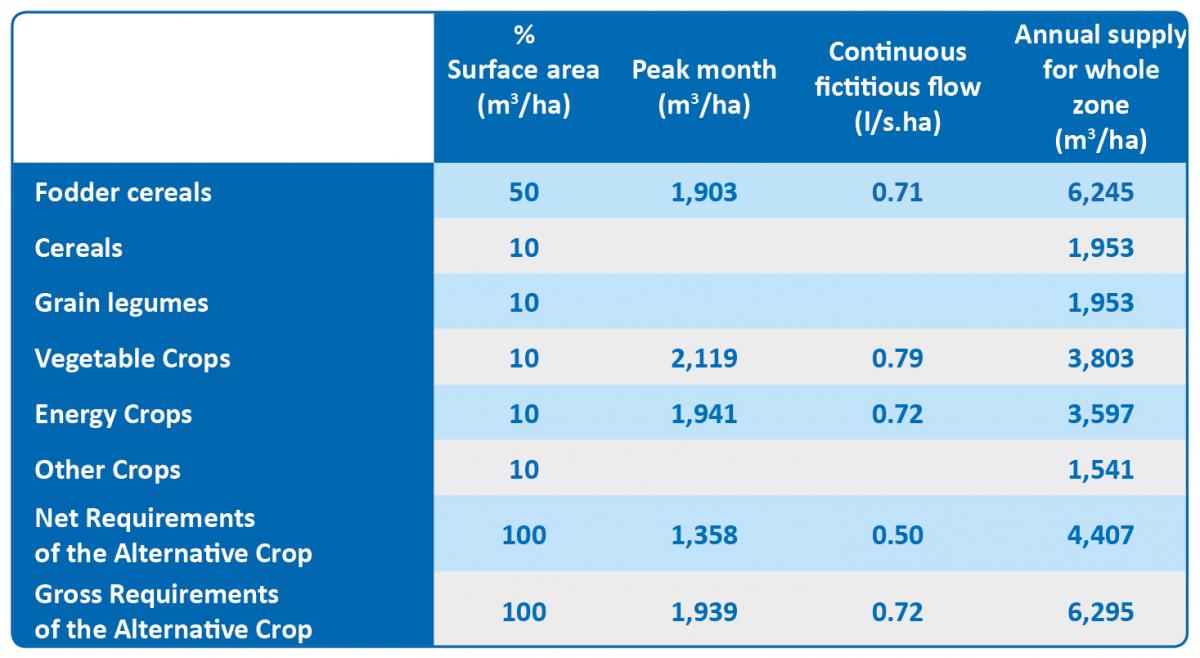
The results that were used for network’s hydraulic design were:
- Continuous fictitious flow: 0.72 l/s ha
- Demand of the alternative per ha: 6,295 m3 ha and year

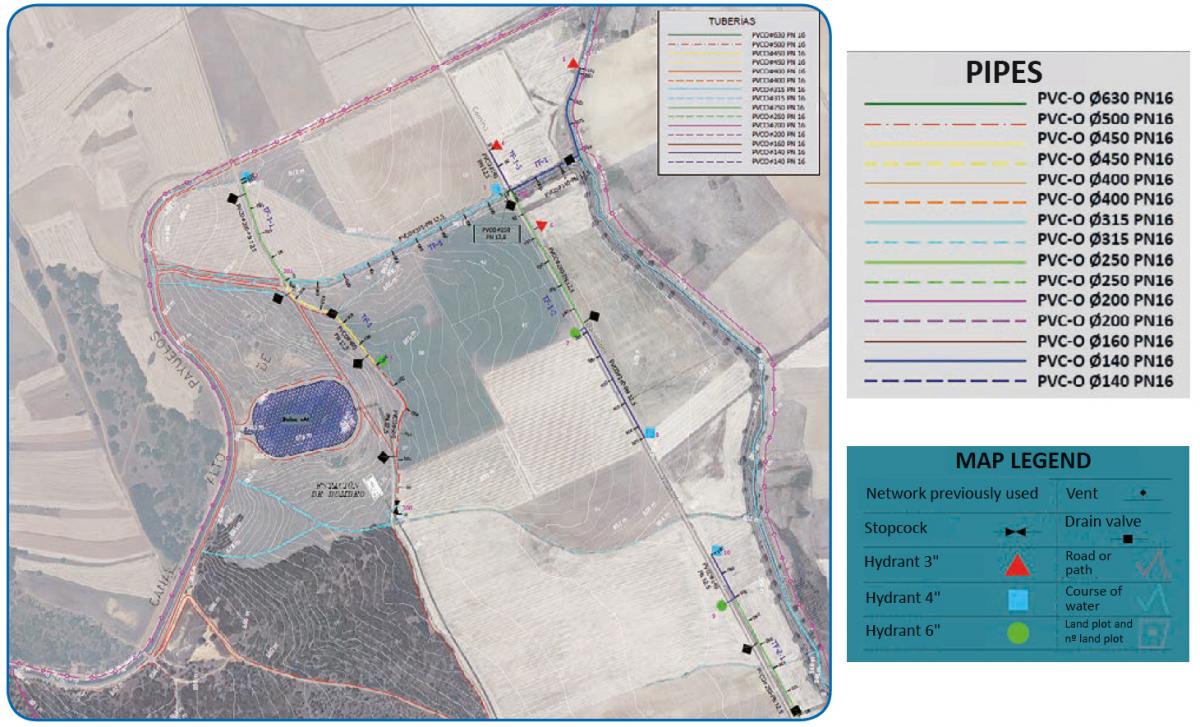

Irrigation running six working days per week were considered, so the continuous fictitious fl ow is 0.84 l/s ha.
An 18-hour irrigation day has been established for the forced water network pressure and 20 hours for the natural water network pressure, so the degrees of freedom were 1.33 and 1.2 respectively.
A 95% guaranteed supply was chosen. The flow that circulates through each of the network’s sections to the demand area is variable throughout the day, since it depends on the likelihood of coinciding with the irrigation of the intakes it supplies. These designed flows will be those that comply with a guaranteed supply and their calculation is based on statistical methods in which it is accepted that the irrigators follow a turn taking distribution of their irrigati on hours.
It is necessary to consider a series of factors to determine the minimum pressure in each section’s points, such as the service pressure of the irrigati on emitters, the irrigation’s uniformity, the different load losses, the topographic changes, etc. A minimum 50 mwg hydrant pressure was established for this project.

It was studied that all the chosen pipes withstood the load forces to which they will be subjected both internally and externally.
In all cases, the calculation was sati sfactory with each of the set installation conditions in the project.
For the mechanical calculations, all the factors that influence the viability of the installation, depth, internal pressure, installation conditions and, of course, traffic loads were taken into account.
The pipes must withstand the combination of forces that the vertical loads of the back fill entail without any problems, as well as the loads from traffic, if any, and the internal pressure of the transported water.
The network was modelled using computer programmes, thus optimising the diameters needed to meet the flow and pressure demand requirements at the supply points, as well as the cost of investment and exploitation of the same, the Oriented PVC material being allocated for this activity.
The range of diameters used in the irrigation network’s pipes were: Orientated PVC pipes (PVC-O) for diameters equal to or smaller than 630 mm, with a 66,127 m length.

All the special parts (changes of direction, bypasses, air and hydrant outlets) of the network are steel with threaded or sharpened outlets to join them to the PVC-O with an elastic joint.

The bends, bypasses, stop valves and all those parts subjected to the thrusts produced by the water’s dynamic and static pressure were subjected to forces whose resultant cannot be absorbed by the supply.
The anchoring consists of a concrete cube whose weight and supporting surface guarantee its stability against sliding. The adherence to the theoretical plane formed by the trench's horizontal depth in which it rests was considered for its calculation, as well as the vertical support surface in one of the trench's parameters, precisely the one which affects the supply's ensuing exterior forces.
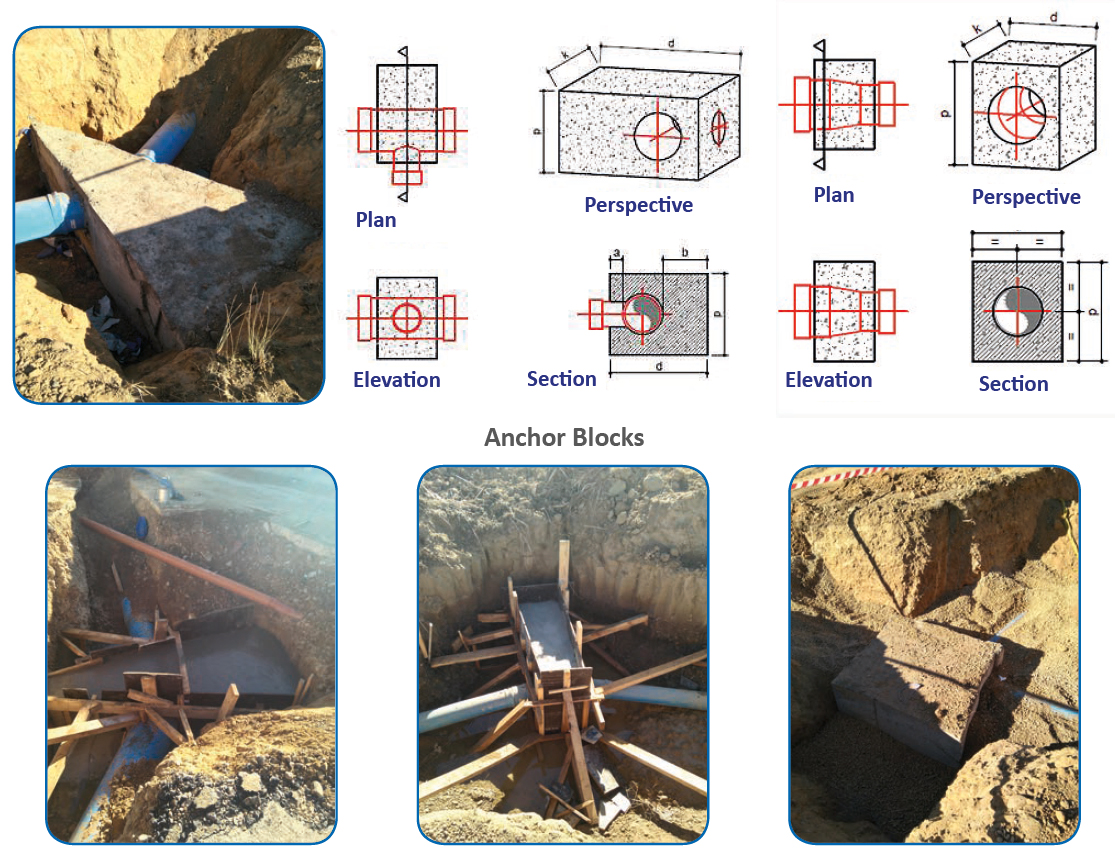

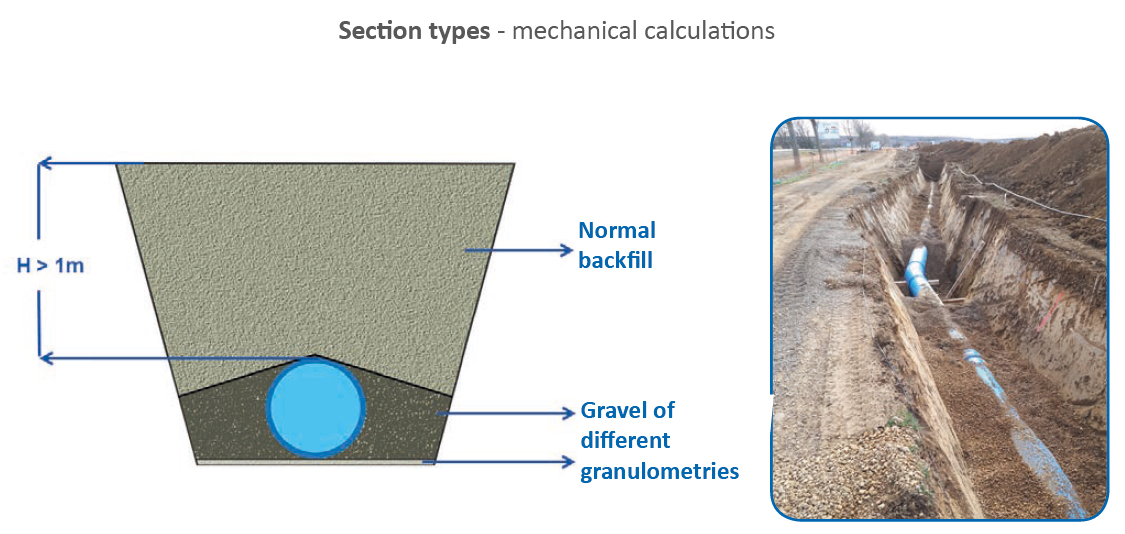
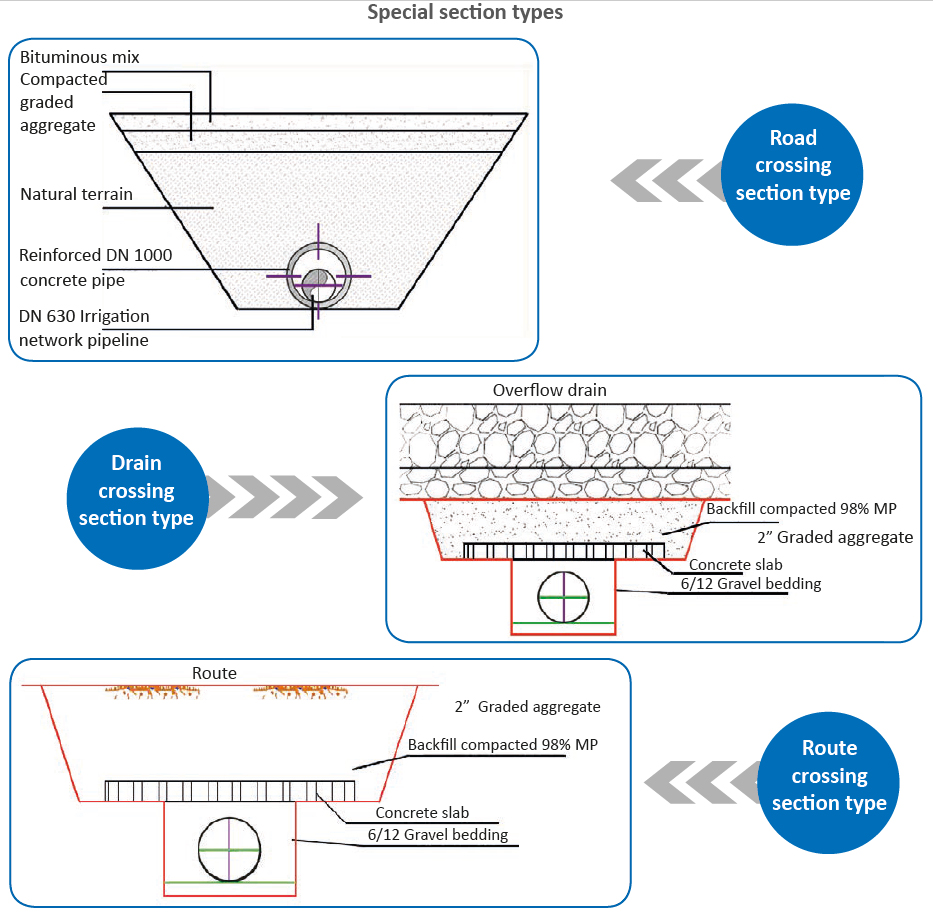
The irrigation network consists of a total of 219 hydrants along with auxiliary and valve parts (butterfly valves and shut-off gate valves for sectoring, gate valves for drainage, air release valves for air outlets, etc.).
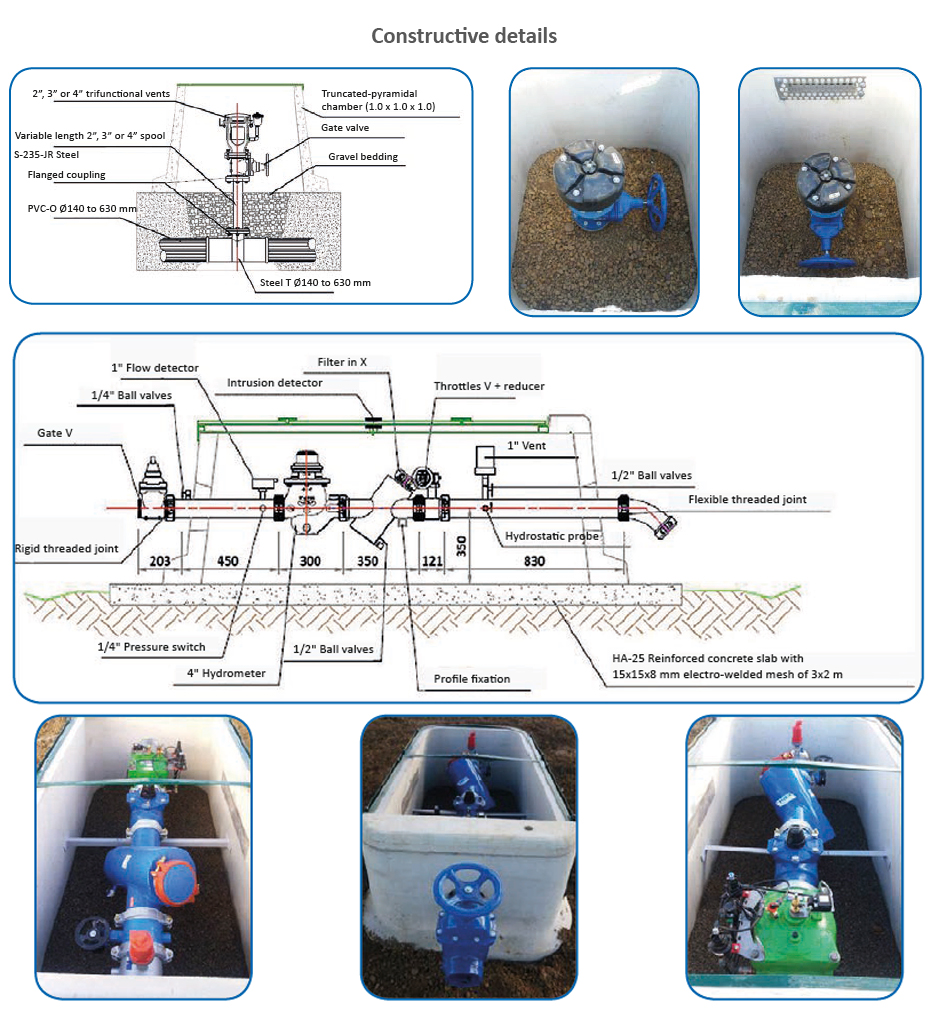
It required the adjustment of its infrastructures for the irrigation network’s layout and dimensioning, to improve their adaptation to the irrigator’s needs and the efficient use of water.
The intended purposes of implementing the latest technologies are: cost savings and improved efficiency in water use, transfer of technology to the irrigation sector, and the use of alternative water resources.
In the network’s design, it is essential to know all those aspects relevant to the economic and technical viability from the project phase. This is fundamental in addressing the main factors for the design, execution, selection of materials and exploitation.
The pipes are a basic element in the networks’ project design, the contrasted quality, their hydraulic capacity and the durability over time must considered for them to remain in service without being affected by mechanical, chemical and micro-biological actions.
The choice of material must be based among other parameters, those that have to do with the installation’s durability, such as: hydraulic capacity, the behaviour of the material against the continuous transitions that occur in an irrigation network, its robustness when handling, ease of installation, the deterioration of the material over time, its roughness and as a consequence of this, its associated load loss, the availability of required accessories in the market or the own energy optimisation.
Therefore, TOM® PVC-O pipes are considered the suitable alternative for irrigation networks thanks to their operational efficiency and their low maintenance costs, due to their high physical-mechanical and chemical properties. A quality, environmentally responsible and economically viable product.
